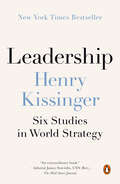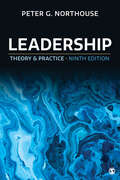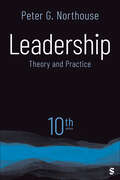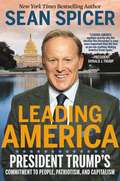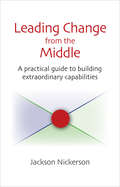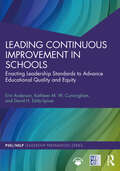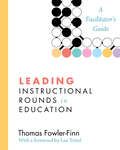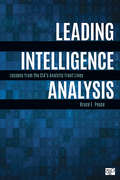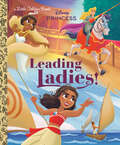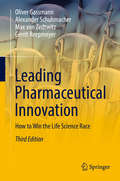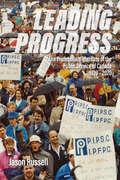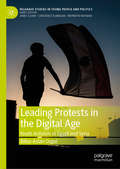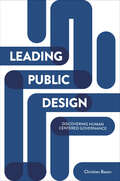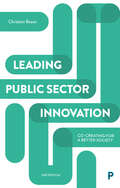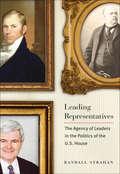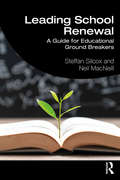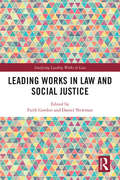- Table View
- List View
Leadership: Kanzlerin Angela Merkels Führungshandeln in Krisen
by Henrike WehrkampPolitisches Handeln ist zunehmend krisenbehaftet und exekutivdominiert. Dabei machen Führungspersönlichkeiten einen Unterschied, wie die vorliegende Studie am Beispiel der „Krisenkanzlerin“ Angela Merkel nachweist. Einem interaktionistischen Leadership-Verständnis folgend wird hier erstmals eine empirisch fundierte, fallvergleichende und persönlichkeitsbezogene Analyse des Krisenmanagements der Bundeskanzlerin vorgelegt. Den Ausgangspunkt bildet eine Leadership Trait Analysis, die den Umgang der Kanzlerin mit Handlungsrestriktionen und Informationen identifiziert und ihre Handlungsmotivation offenlegt. Auf dieser Grundlage wird ihr Führungshandeln in der Eurokrise und der Migrationskrise untersucht. Die systematische Rekonstruktion der Krisengeschehen lässt den Schluss zu, dass Merkels politische Führung eine Frage der Persönlichkeit ist.
Leadership: Six Studies in World Strategy
by Henry KissingerThe New York Times bestsellerHenry Kissinger, consummate diplomat and statesman, examines the strategies of six great twentieth-century figures and brings to life a unifying theory of leadership and diplomacy&“An extraordinary book, one that braids together two through lines in the long and distinguished career of former Secretary of State Henry Kissinger...In Leadership he presents a fascinating set of historical case studies and political biographies that blend the dance and the dancer, seamlessly.&” - James Stavridis, The Wall Street Journal&“Leaders,&” writes Henry Kissinger in this compelling book, &“think and act at the intersection of two axes: the first, between the past and the future; the second, between the abiding values and aspirations of those they lead. They must balance what they know, which is necessarily drawn from the past, with what they intuit about the future, which is inherently conjectural and uncertain. It is this intuitive grasp of direction that enables leaders to set objectives and lay down a strategy.&” In Leadership, Kissinger analyses the lives of six extraordinary leaders through the distinctive strategies of statecraft, which he believes they embodied. After the Second World War, Konrad Adenauer brought defeated and morally bankrupt Germany back into the community of nations by what Kissinger calls &“the strategy of humility.&” Charles de Gaulle set France beside the victorious Allies and renewed its historic grandeur by &“the strategy of will.&” During the Cold War, Richard Nixon gave geostrategic advantage to the United States by &“the strategy of equilibrium.&” After twenty-five years of conflict, Anwar Sadat brought a vision of peace to the Middle East by a &“strategy of transcendence.&” Against the odds, Lee Kuan Yew created a powerhouse city-state, Singapore, by &“the strategy of excellence.&” And, though Britain was known as &“the sick man of Europe&” when Margaret Thatcher came to power, she renewed her country&’s morale and international position by &“the strategy of conviction.&” To each of these studies, Kissinger brings historical perception, public experience and—because he knew each of the subjects and participated in many of the events he describes—personal knowledge. Leadership is enriched by insights and judgements that only Kissinger could make and concludes with his reflections on world order and the indispensability of leadership today.
Leadership: Theory and Practice
by Peter G. NorthouseAdopted at more than 1,600 institutions in 89 countries and translated into 15 different languages! The market-leading Leadership: Theory and Practice by Peter G. Northouse presents an academically robust account of the major theories and models of leadership with a focus on how theory can inform practice. Northouse uses a consistent structure for each chapter that allows readers to easily compare and contrast different theories. Case studies and questionnaires provide students with practical examples and opportunities to deepen their understanding of their own leadership style. The fully updated Ninth Edition features a new chapter on inclusive leadership, 17 new real-world cases that profile leaders from across the globe, a new discussion on leadership and morality, and examples of timely issues such as leadership during the COVID-19 pandemic. This title is accompanied by a complete teaching and learning package.
Leadership: Theory and Practice
by Peter G. NorthouseAdopted at more than 1,600 institutions in 89 countries and translated into 15 different languages! The market-leading Leadership: Theory and Practice by Peter G. Northouse presents an academically robust account of the major theories and models of leadership with a focus on how theory can inform practice. Northouse uses a consistent structure for each chapter that allows readers to easily compare and contrast different theories. Case studies and questionnaires provide students with practical examples and opportunities to deepen their understanding of their own leadership style. The fully updated Ninth Edition features a new chapter on inclusive leadership, 17 new real-world cases that profile leaders from across the globe, a new discussion on leadership and morality, and examples of timely issues such as leadership during the COVID-19 pandemic. This title is accompanied by a complete teaching and learning package.
Leadership: Theory and Practice
by Peter G. NorthouseNow with a new chapter on Social Identity Leadership! Adopted in thousands of courses in 89 countries and translated into 15 different languages, this market-leading text successfully combines an academically robust account of the major theories and models of leadership with an accessible style and focus on how leadership theory can inform leadership practice. Peter G. Northouse uses a consistent structure for each chapter, allowing readers to easily compare and contrast different theories. Case studies and questionnaires provide students with practical examples and opportunities to deepen their understanding of their own leadership style.
Leadership: Theory and Practice
by Peter G. NorthouseNow with a new chapter on Social Identity Leadership! Adopted in thousands of courses in 89 countries and translated into 15 different languages, this market-leading text successfully combines an academically robust account of the major theories and models of leadership with an accessible style and focus on how leadership theory can inform leadership practice. Peter G. Northouse uses a consistent structure for each chapter, allowing readers to easily compare and contrast different theories. Case studies and questionnaires provide students with practical examples and opportunities to deepen their understanding of their own leadership style.
Leading America: President Trump's Commitment to People, Patriotism, and Capitalism
by Sean SpicerThe former White House Press Secretary and Communications Director analyzes our current political moment through the lens of politics and culture and argues that President Trump has put the country back on the right track and needs to be reelected in 2020.When it was announced that Sean Spicer would be the newest guest on ABC's Dancing with the Stars, he was promptly attacked by countless liberal media institutions. Apparently, they'd rather see him crawl under a rock forever than have a little fun on television (while raising money for charity). And that was only a small example. All over the country, liberals are attacking conservatives with the kind of fervor once reserved for hardened criminals. It's a zero sum game -- either you're with them one hundred percent, or you're the enemy. Whether you're in politics, media, academia, or entertainment, it's the same story.As one of the few people who's played a small part in all of those worlds, Sean Spicer has a unique perspective on the methods used by the left to shut down conservative voices. He's been parodied on SNL, ripped apart on the nightly news, and protested on college campuses, all for doing his job. Outside of the left's bubble, however, he's been able to transition from politics to entertainment very well, and he's got huge numbers of supporters.In Leading America, he writes about all the ways President Trump has fought back against the Left, and examines all the ways conservatives can take a stand to uphold their rights and values.
Leading Change from the Middle
by Jackson NickersonBookshelves abound with theoretical analyses, how-to guides, and personal success stories by famous corporate leaders, public officials, even athletic coaches, expounding on how to lead from the top. But what about those in the middle who are increasingly tasked with trying to reshape, reorient, or recreate the capabilities of an organization? Leading Change from the Middle takes you on the journeys traveled by Kurt Mayer, an information technology executive in the Department of Defense trying to build a new IT system in record time with limited resources, and Stephen Wang, a mid-level leader in city government trying to build a capability for supporting commercial agriculture. Kurt and Stephen have to navigate complex organizational and stakeholder landscapes in which they often have few decision rights and few resources--a common scenario for mid-level leaders. One succeeds; one does not.While following Kurt and Stephen, the book introduces a new approach for increasing the likelihood of successfully leading change. This new approach breaks down into three core strategies: First, identify all relevant stakeholders and partition them into four categories: superordinates, subordinates, customers, and complementors/blockers (those who control needed resources but over whom the leaders have no authority).Second, for each stakeholder category, identify Communications, Strategies, and Tactics (referred to as CoSTS).Third, don't stimulate negative emotions that make people DEAF--Disrespect, Envy, Anger, and Fear--to efforts to produce change. As the book follows the journeys of Kurt and Stephen, it walks through the details of each strategy.In presenting this material in a concise, accessible, and applicable format that translates theory to practice, Nickerson provides an important service for leaders trying to build extraordinary capabilities for their organizations--from the middle.
Leading Change from the Middle
by Jackson NickersonBookshelves abound with theoretical analyses, how-to guides, and personal success stories by famous corporate leaders, public officials, even athletic coaches, expounding on how to lead from the top. But what about those in the middle who are increasingly tasked with trying to reshape, reorient, or recreate the capabilities of an organization? Leading Change from the Middle takes you on the journeys traveled by Kurt Mayer, an information technology executive in the Department of Defense trying to build a new IT system in record time with limited resources, and Stephen Wang, a mid-level leader in city government trying to build a capability for supporting commercial agriculture. Kurt and Stephen have to navigate complex organizational and stakeholder landscapes in which they often have few decision rights and few resources-a common scenario for mid-level leaders. One succeeds; one does not.While following Kurt and Stephen, the book introduces a new approach for increasing the likelihood of successfully leading change. This new approach breaks down into three core strategies: First, identify all relevant stakeholders and partition them into four categories: superordinates, subordinates, customers, and complementors/blockers (those who control needed resources but over whom the leaders have no authority).Second, for each stakeholder category, identify Communications, Strategies, and Tactics (referred to as CoSTS).Third, don't stimulate negative emotions that make people DEAF-Disrespect, Envy, Anger, and Fear-to efforts to produce change. As the book follows the journeys of Kurt and Stephen, it walks through the details of each strategy.In presenting this material in a concise, accessible, and applicable format that translates theory to practice, Nickerson provides an important service for leaders trying to build extraordinary capabilities for their organizations-from the middle.
Leading Continuous Improvement in Schools: Enacting Leadership Standards to Advance Educational Quality and Equity (PSEL/NELP Leadership Preparation)
by Erin Anderson Kathleen M. Cunningham David H. Eddy-SpicerThis volume provides a set of principles and systematic methods for improvement to help district and school leaders achieve the continuous improvement goals embedded in the Professional Standard for Educational Leadership (PSEL) and the National Educational Leadership Program (NELP) standards. Bringing the PSEL Standard 10 to life, this book tackles the why, how, and what of continuous improvement through an equity lens. In the first section, Leading Continuous Improvement in Schools provides an overall introduction to and rationale for continuous improvement, situating current approaches to continuous improvement, situating current approaches to continuous improvement in education within broader historical and sectoral contexts. The second section highlights how the tenets of improvement science – such as making iterative, incremental, evidence-based advancements; utilizing practical measurements; and acknowledging variability – position school and system leaders to adaptively integrate systematic and evidence-based approaches to change as part of ongoing organizational processes. The book concludes with a section that invites readers to consider leadership approaches that forward improvement work, how leaders can build internal capacity to engage in improvement, and how policy can support efforts to build and sustain the capacity for continuous improvement. Special features include beginning-of-chapter highlights, end-of-chapter connections to standards, and action inventories through each chapter. Overall, the volume provides a focus on the continuous improvement aspects of the NELP and PSEL standards that serves as a bridge, supporting students preparing to become educational leaders in their journey from learning about continuous improvement to learning how to lead continuous, equity-oriented improvement work in their own contexts.
Leading Continuous Improvement in Schools: Enacting Leadership Standards to Advance Educational Quality and Equity (PSEL/NELP Leadership Preparation)
by Erin Anderson Kathleen M. Cunningham David H. Eddy-Spicer• Aligns improvement efforts with two sets of standards, NELP and PSEL – no other books in the field do this. • To help ground the main points in this volume, each chapter features a case that presents a leader who is simultaneously leading a school while also learning about improvement science in their graduate class. • To help instructors use this book in their courses, each chapter includes teaching notes and an action inventory aligned to the case examples and chapters. • Uses Improvement Science as a method of continuous change and equity as a values framework—this book centers equity in every improvement effort • This book helps to reframe the conversation about how data can be used by leaders for improvement -- it emphasizes creating a data culture that allows for experimentation and learning from failure and does not limit emphasis on lagging accountability data. • This book is comprehensive with attention to foundational theory and research on continuous improvement, practical methods of continuous improvement, and the leadership of continuous improvement
Leading Instructional Rounds in Education: A Facilitators Guide
by Lee Teitel Thomas Fowler-FinnInstructional rounds is a powerful form of professional learning aimed at helping schools and systems develop the capacity to educate all children to high levels. In this practical book, Thomas Fowler-Finn, an experienced consultant who has worked closely with the Harvard team that pioneered instructional rounds, discusses how facilitators can skillfully guide a network of educators through the rounds process. He shows how to scaffold participant learning, model effective teaching practices, and gradually transfer agency to the network. Leading Instructional Rounds is an invaluable resource for advancing the work of all facilitators, whether novice or experienced.
Leading Instructional Rounds in Education: A Facilitator’s Guide
by Thomas Fowler-FinnInstructional rounds is a powerful form of professional learning aimed at helping schools and systems develop the capacity to educate all children to high levels. In this practical book, Thomas Fowler-Finn, an experienced consultant who has worked closely with the Harvard team that pioneered instructional rounds, discusses how facilitators can skillfully guide a network of educators through the rounds process. He shows how to scaffold participant learning, model effective teaching practices, and gradually transfer agency to the network. Leading Instructional Rounds is an invaluable resource for advancing the work of all facilitators, whether novice or experienced.
Leading Intelligence Analysis: Lessons from the CIA’s Analytic Front Lines
by Bruce E. Pease"Bruce Pease has written a much needed book on a long ignored topic: how does one lead analysts? Most analysis is at some level a group activity, whether in government or the private sector. Much has been written about good versus bad analysis and how to train analysts, but Pease, himself a veteran senior CIA analyst and manager, focuses on what the leaders of these analysts need to know and should be thinking about. Leadership matters in analysis as in all other endeavors, and Pease offers invaluable guidance on how to lead effectively. This book is a must for anyone in a leadership role in an analytic enterprise." —Mark M. Lowenthal, PhD, Intelligence & Security Academy, LLC Written by an experienced professional who has led Navy Intelligence and CIA analysts in high-stakes situations, Leading Intelligence Analysis introduces the fundamental managerial skills and practical tools needed to lead analysis projects conducted by individuals and teams. Author Bruce Pease provides insights into key questions such as What kind of environment draws out a team’s best work? What brings out their creativity? When does pressure bring out their best insights? When does pressure sap their intellectual energy? and What kind of team builds new knowledge rather than engaging in group-think? This book draws on the author’s perspective from decades of leading intelligence analysts on critical issues, including war in the Middle East, terrorism after 9/11, and nuclear threats. Key Features Practical advice helps leaders of analytic units nurture insight with the understanding that it can be enabled but not manufactured. Discussion of a range of different types of analysis serves leaders conducting research in areas including data analysis, security analysis, geopolitical analysis, threat warning, counterterrorism, and business climate analysis. Practical advice on judging IT tools guides leaders to the correct data science approach for various situations.
Leading Intelligence Analysis: Lessons from the CIA’s Analytic Front Lines
by Bruce E. Pease"Bruce Pease has written a much needed book on a long ignored topic: how does one lead analysts? Most analysis is at some level a group activity, whether in government or the private sector. Much has been written about good versus bad analysis and how to train analysts, but Pease, himself a veteran senior CIA analyst and manager, focuses on what the leaders of these analysts need to know and should be thinking about. Leadership matters in analysis as in all other endeavors, and Pease offers invaluable guidance on how to lead effectively. This book is a must for anyone in a leadership role in an analytic enterprise." —Mark M. Lowenthal, PhD, Intelligence & Security Academy, LLC Written by an experienced professional who has led Navy Intelligence and CIA analysts in high-stakes situations, Leading Intelligence Analysis introduces the fundamental managerial skills and practical tools needed to lead analysis projects conducted by individuals and teams. Author Bruce Pease provides insights into key questions such as What kind of environment draws out a team’s best work? What brings out their creativity? When does pressure bring out their best insights? When does pressure sap their intellectual energy? and What kind of team builds new knowledge rather than engaging in group-think? This book draws on the author’s perspective from decades of leading intelligence analysts on critical issues, including war in the Middle East, terrorism after 9/11, and nuclear threats. Key Features Practical advice helps leaders of analytic units nurture insight with the understanding that it can be enabled but not manufactured. Discussion of a range of different types of analysis serves leaders conducting research in areas including data analysis, security analysis, geopolitical analysis, threat warning, counterterrorism, and business climate analysis. Practical advice on judging IT tools guides leaders to the correct data science approach for various situations.
Leading Ladies! (Little Golden Book)
by Holly RiceAll thirteen Disney princesses take center stage in this beautifully illustrated Little Golden Book about leadership, empowerment, and community!Learn about what it takes to be a leader from Disney&’s leading ladies, the Disney princesses! See how Mulan teaches young soldiers, Tiana directs junior chefs, Moana guides her mighty island village, and more! With themes of leadership, fun, empowerment, and community, this book is perfect for future leaders ages 2 to 5 who love the Disney princesses!
Leading Pharmaceutical Innovation: Trends And Drivers For Growth In The Pharmaceutical Industry
by Alexander Schuhmacher Oliver Gassmann Max Von Zedtwitz Gerrit ReepmeyerPharmaceutical giants have been doubling their investments in drug development, only to see new drug approvals to remain constant for the past decade. This book investigates and highlights a set of proactive strategies, aimed at generating sustainable competitive advantage for its protagonists based on value-generating business practices. We focus on three sources of pharmaceutical innovation: new management methods in the drug development pipeline, new technologies as enablers for cutting-edge R&D, and new forms of internationalisation, such as outside-in innovation in the early phases of R&D.
Leading Progress: The Professional Institute of the Public Service Canada 1920–2020
by Jason RussellOn February 6, 1920, a small group of public service employees met for the first time to form a professional association. A century later, the Professional Institute of the Public Service Canada (PIPSC) is a bargaining agent representing close to 60,000 public sector workers, whose collective efforts for the public good have touched the lives of every Canadian. Published on the centennial of PIPSC’s founding, Leading Progress is the definitive account of its evolution from then to now—and a rare glimpse into an under-studied corner of North American labour history. Researcher Dr. Jason Russell draws on a rich collection of sources, including archival material and oral history interviews with dozens of current and past PIPSC members. The story that unfolds is a complex one, filled with success and struggle, told with clarity and even-handedness. After decades of demographic and generational shifts, economic booms and busts, and political sea change, PIPSC looks toward its next hundred years with its mission as strong as ever: to advocate for social and economic justice that benefits all Canadians.
Leading Protests in the Digital Age: Youth Activism in Egypt and Syria (Palgrave Studies in Young People and Politics)
by Billur Aslan OzgulThis book explores in detail new protest organisation and mobilisation strategies of young activists in the digital age with the aim to identify the tactics that worked well against those creating high risks in the context of digitally supported protests. Focusing on Egyptian protests as well as peaceful protests in Syria, the book offers rich and unique data as it brings together the experiences and voices of the key figures involved in the protests, both on the ground and online. It challenges perspectives that defined the Arab uprisings as leaderless movements formed through the non-hierarchical communication of digital technologies. The author presents three kinds of leaders that shape the political communication environment in digitally supported protests and highlights the significance of their leadership skills to the movements’ capacities.
Leading Public Design: Discovering Human-Centred Governance
by Christian BasonThis powerful new book provides a clear framework for understanding and learning an emerging management practice, leading public design. Drawing on more than a decade of work on public sector innovation, Christian Bason uses his extensive practical experience and research conducted among public managers in the UK, the US, Australia, Finland and Denmark to explore how public organisations can be redesigned from the outside in, shaping policies and services that are truly experienced as useful and meaningful to citizens, and which leverage all of society’s resources to co-produce better outcomes. Through detailed case studies, the book presents six management practices which leaders in government can use to involve citizens, staff and other stakeholders in innovation processes. It shows how managers can challenge their own assumptions, leverage empathy with citizens, handle divergence, navigate unknown territory, experiment and rehearse future solutions through prototyping, and create more public value. Ultimately, Leading public design provides a pathway to a new and different way of governing public institutions: human-centred governance. As a more relational, networked, interactive and reflective approach to running organisations, this emerging governance model promises a more human yet effective public sector.
Leading Public Sector Innovation 2E: Co-creating for a Better Society
by Christian BasonThe second edition of this significant text has been thoroughly revised to take account of the latest literature, case studies and international developments in the field. Drawing on global research and practical examples, Bason illustrates the key triggers and practices of public sector innovation. Each chapter includes a refined ‘how to do it’ toolkit, and two new chapters have been added, one which discusses the rise of innovation labs in the public sector, and a practical chapter focused on change leadership, to complement the existing chapter on leadership roles. The book will be a valuable resource for researchers and students in public administration, management and policy, as well as managers, project managers and staff in public sector organisations.
Leading Representatives: The Agency of Leaders in the Politics of the U.S. House (Interpreting American Politics)
by Randall StrahanMany studies of Congress hold that congressional leaders are "agents" of their followers, ascertaining what legislators agree on and acting to advance those issues rather than stepping to the forefront to shape national policy or the institution they lead. Randall Strahan has long argued that this approach to understanding leadership is incomplete. Here he demonstrates why and explores the independent contributions leaders make in congressional politics.Leading Representatives is a study that draws on both historical and contemporary cases to show how leaders in the U.S. House have advanced changes inside Congress and in national policy. Exploring the tactics, tenure, and efficacy of the leadership of three of the most colorful and prominent Speakers of the House—Henry Clay, Thomas Reed, and Newt Gingrich—Strahan finds that these men, though separated in time and of differing thought and actions, were all leaders willing to take political risks to advance goals they cared about deeply. As a result, each acted independently of his followers to alter the political landscape. Strahan makes use of a wide range of resources, including the former representatives' papers and correspondence and interviews with Gingrich and his staffers, to demonstrate how these important leaders influenced policy and politics and where they ran aground.In expounding lessons Strahan has gleaned over two decades of studying U.S. legislative politics, Leading Representatives offers a new theoretical framework—the conditional agency perspective—that effectively links contextual perspectives as applied to congressional leadership with those emphasizing characteristics of individual leaders. This engagingly written book will be of interest to political scholars of all stripes as well as readers inclined to learn more about the history and inner workings of the House.
Leading Representatives: The Agency of Leaders in the Politics of the U.S. House (Interpreting American Politics)
by Randall StrahanAn in-depth examination of the role U.S. House leadership plays in shaping America’s national policy and political system.Many studies of Congress hold that congressional leaders are “agents” of their followers, ascertaining what legislators agree on and acting to advance those issues rather than stepping to the forefront to shape national policy or the institution they lead. Randall Strahan argues that this approach to understanding leadership is incomplete. Here he demonstrates why and explores the independent contributions leaders make in congressional politics.Leading Representatives is a study that draws on both historical and contemporary cases to show how U.S. House leaders have advanced changes inside Congress and in national policy. Exploring the tactics, tenure, and efficacy of the leadership of three of the most colorful and prominent Speakers of the House—Henry Clay, Thomas Reed, and Newt Gingrich—Strahan finds that these men, though separated in time and of differing thought and actions, were all leaders willing to take political risks to advance goals they cared about deeply. As a result, each acted independently of his followers to alter the political landscape. Strahan makes use of a wide range of resources, including the former representatives’ papers and correspondence and interviews with Gingrich and his staffers, to demonstrate how these important leaders influenced policy and politics and where they ran aground.In expounding lessons Strahan has gleaned over two decades of studying U.S. legislative politics, Leading Representatives offers a new theoretical framework—the conditional agency perspective—that effectively links contextual perspectives as applied to congressional leadership with those emphasizing characteristics of individual leaders.
Leading School Renewal: A Guide for Educational Ground Breakers
by Steffan Silcox Neil MacNeillLeading School Renewal explores how school principal leadership behaviour impacts on school change endeavours, and in particular pedagogic renewal, which is a form of educational improvement that is primarily concerned with the growing of the knowledge, skills and beliefs of education in a manner that optimises students’ life options. The authors identify attributes of principals who have engaged in school renewal and examine the influences on their leadership behaviours and disposition towards renewing their schools while also acknowledging the influence of site-specific contextual variables. The authors propose that certain leadership behaviours exhibited by school principals are integral with renewing a school’s pedagogic focus. They argue renewal is a preferred form of sustainable educational change because it relates to deep-seated cultural changes in approaches to pedagogy, curriculum and school structures. Whilst also maintaining that leadership is at the heart of school improvement and principal leadership practices which are based on a clear sense of purpose, values and beliefs about learning and teaching can transform a school into a learning organisation. Including a foreword by Professor John Hattie, this book is appropriate for all school leaders and educators who want to learn more about school leadership behaviours and highly effective school change.
Leading Works in Law and Social Justice (Analysing Leading Works in Law)
by Faith Gordon and Daniel NewmanThis book assesses the role of social justice in legal scholarship and its potential future development by focusing upon the ‘leading works’ of the discipline. The rise of socio-legal studies over recent decades has led to a more interdisciplinary approach to the study of law, which prioritises placing law into its wider social context. Recognising the role that culture, economics and politics play in the development of law is important in order to fully understand the position and impact of law in society. Innovative and written in an engaging way, this collection includes leading and emerging scholars from across the world. Each contributor has been invited to select and analyse a ‘leading work’, a publication which has for them shed light on the way that law and social justice are interlinked and has influenced their own understanding, scholarship, advocacy, and, in some instances, activism. The book also includes a specially written foreword and afterword, which critically reflect upon the contributions of the 'leading works' to consider the role that social justice has played in law and legal education and the likely future path for social justice in legal scholarship. This book will be an essential resource for all those working in the areas of social justice, socio-legal studies and legal philosophy. It will be of wider interest to the social sciences more generally.

